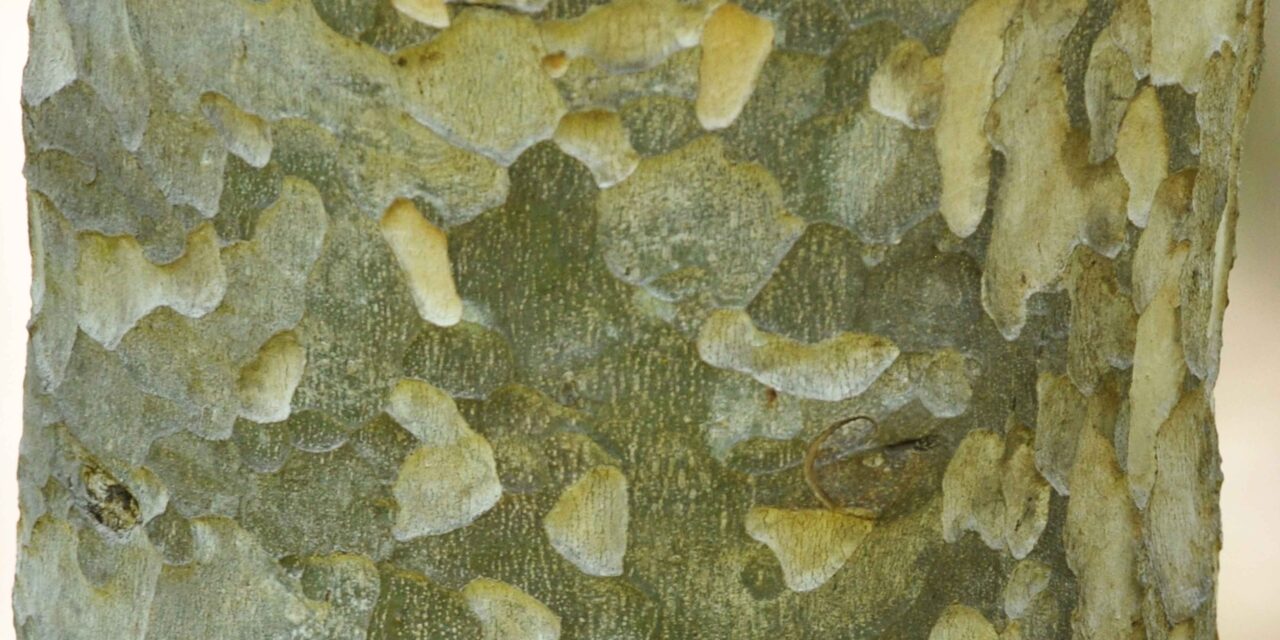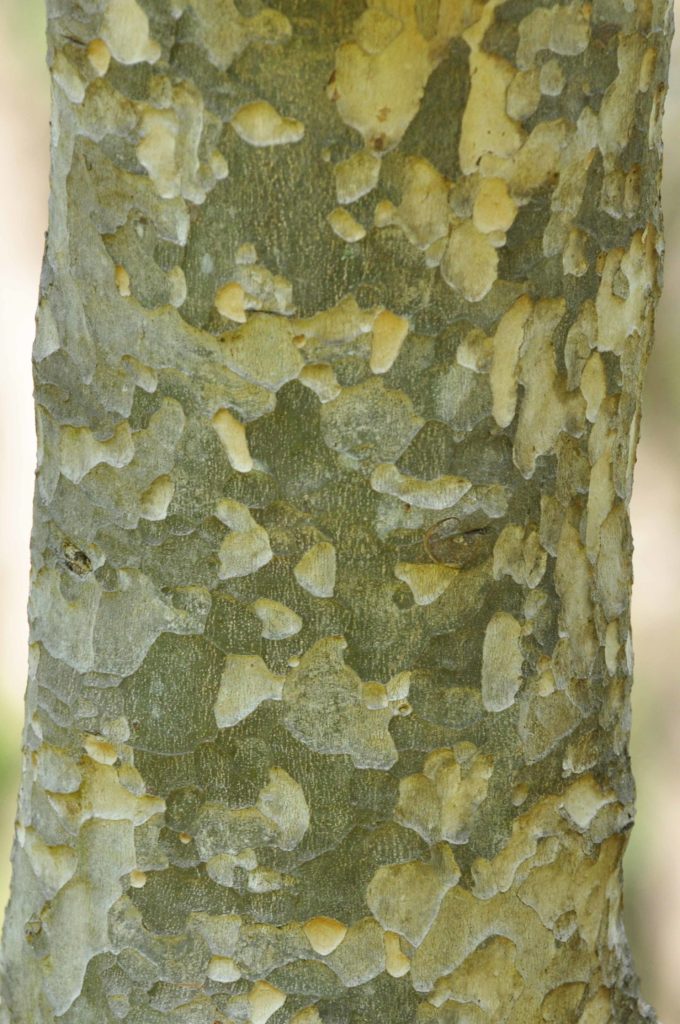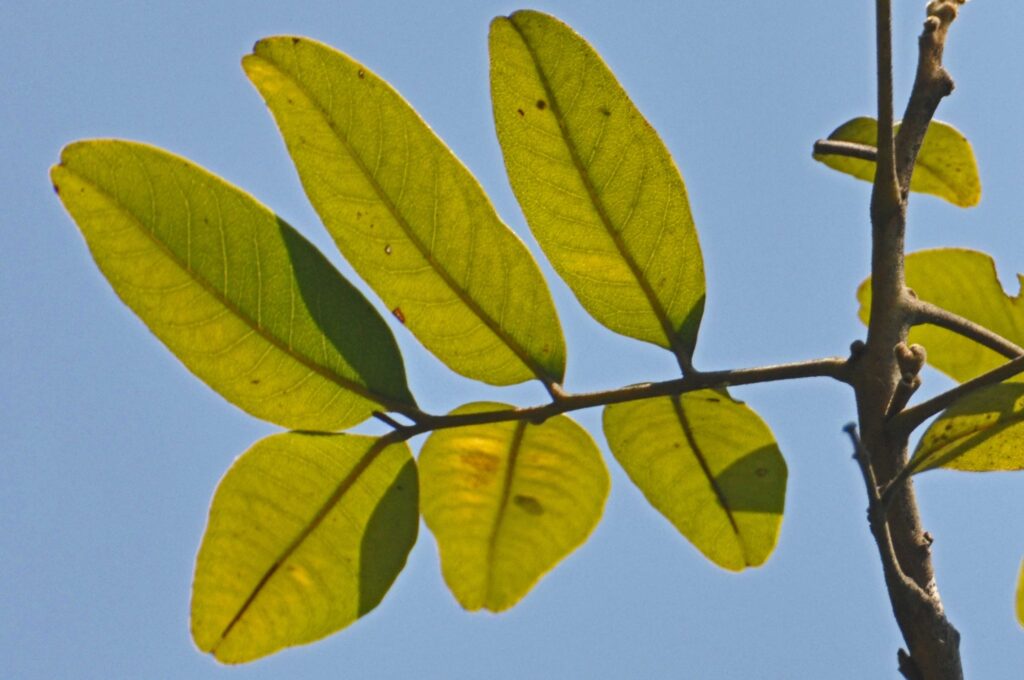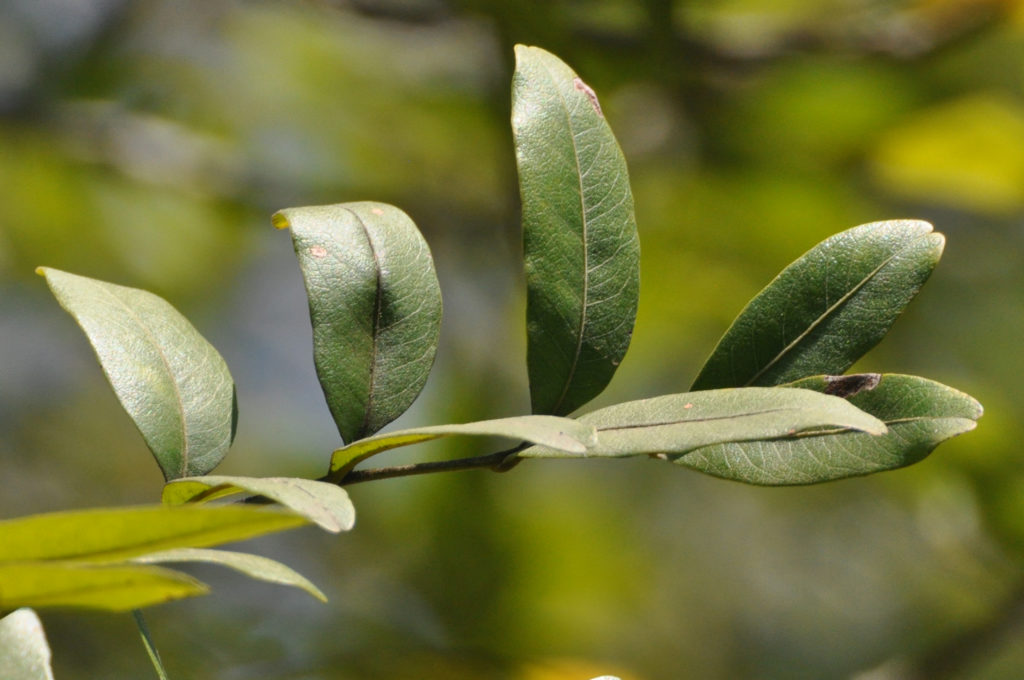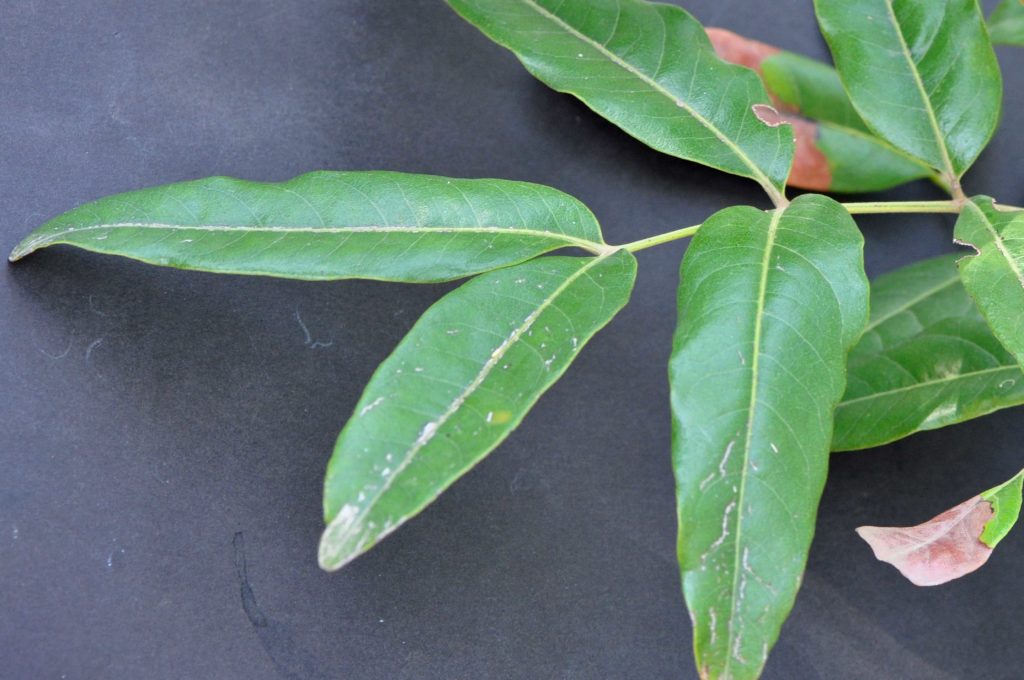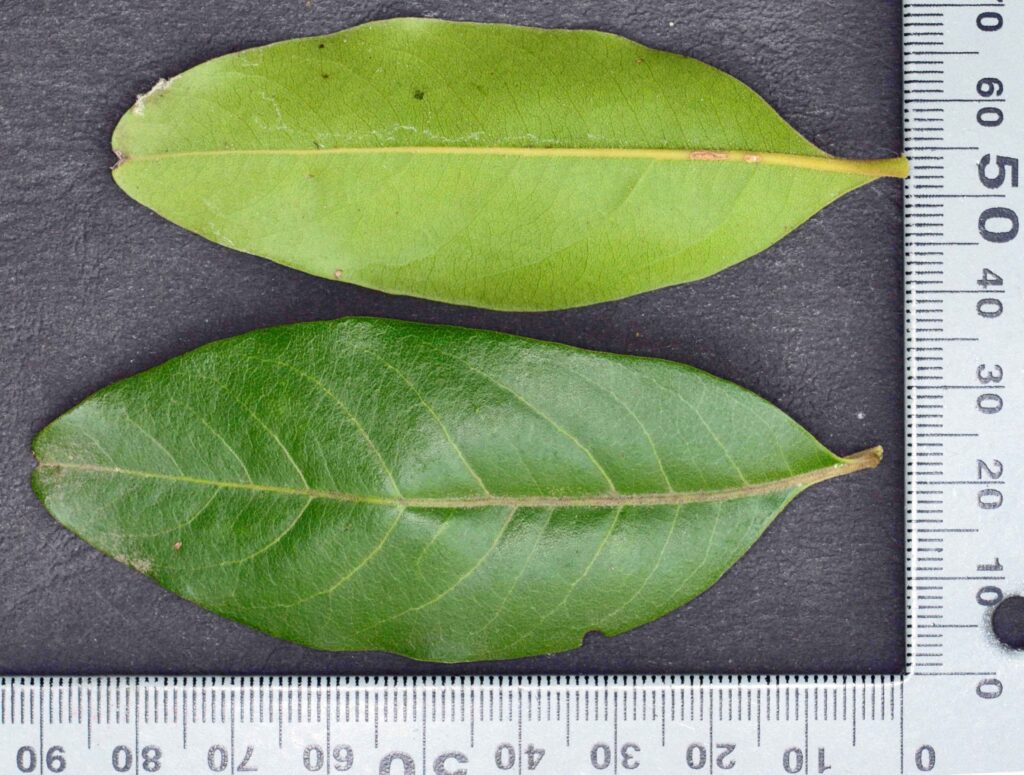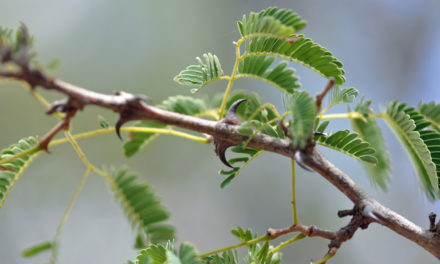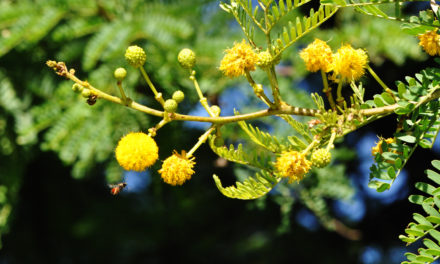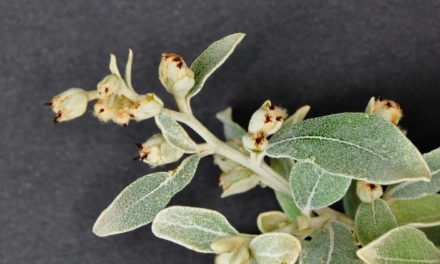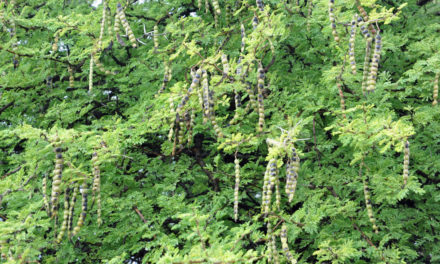General Info – summary
This monoecious small to medium sized Tree is up to 8m high in SA – taller further north. The distinctive bark has roughly mottled flakes. Paripinnate Leaves lack stipules and the up to 4 pairs of leaflets are opposite and asymmetric. Tiny unisexual, scented, 5-merous, racemose & unisexual Flowers lack petals. The ovoid to almost spherical Fruit is a silky-haired capsule developing brown seeds coated with an aril.
Description
Stadmannia oppositifolia subsp. rhodesica.
Previous Names: Melanodiscus venulosus.
SA Tree No. 435.
Common names: (Afr) Sypruim. (Eng) Bourbon iron wood, Silky Plum, Silky-plum, Iron wood.
Family: Sapindaceae: (Soapberry and Litchi family). This family has 135 genera and about 1 800 species. The alternate, usually compound Leaves often lack stipules (leaf stalk) and have a swollen base. The small, usually unisexual, Flowers may be regular or irregular and develop in racemes or panicles. The Calyx has 4-5 lobes and, when present, the Corolla has 3-5 petals. There are between 5 and 24 Stamens, which have free Filaments and the Anthers have 2 pollen sacs. The superior Ovary may have up to 3 styles, each ending in a simple stigma. There are 27 species in 14 genera in southern Africa. Local genera with trees on this website include Allophylus, Atalaya, Dodonaea, Erythrophysa, Filicium, Hippobromus, Pappea, Smelophyllum and Stadmannia.
Name derivation: Stadmannia – named after a German botanist M. Stadtmann. oppositifolia – opposite leaves/leaflets. subsp. rhodesica – from Rhodesia – now Zimbabwe – where the type specimen was collected. oppositifolia is the only species of the genus Stadmannia.
Conservation: National Status: L C. (Least Concern). Assessed: van Wyk, A.E. & Victor, J.E. 2005..
Tree
Within South Africa, this spineless Tree may reach 8m high. Further north the tree may reach 20m. This plant may also be multi-stemmed from the base and may scramble. The Bark is yellow or brown. It becomes grey with roughly concentric flakes exposing yellow underneath. The newly flaked areas are yellow, older areas are light grey and the oldest part is a darker grey. This gives an overall distinctive blotchy, mottled appearance (photo 659). Branches are greyish, tomentose (covered with densely matted woolly hairs) and eventually glabrescent (becoming hairless). Young Branchlets may have small brown hairs.
- 659 2014.09.14 Lowveld NBG. Photo: David Becking.
Leaves
This evergreen tree usually has alternate Leaves that become almost hairless. Each is up to 15cm long and paripinnate (pinnately compound leaf ending in a pair of leaflets – photo 697). There are up to 4 pairs of leathery, elliptic to oblong Leaflets (photo 697) that are up to about 8,5 x 3,6cm. The lowest pair are the smallest. These leaflets are opposite or nearly so (photo 662), and leaflet are asymmetric (not equal to the opposite side – (photos 662 & 664). The Blade is shiny dark green on the upper side (photo 697) and lighter green with very small visible net veins and hairs on the lower side. The Midrib is raised and dark above and is the only hairy part. It is raised and prominent below. The leaflet Apex is rounded and often indented (photo 662). The Base (photo 664) tapers. The slightly rolled under Margin is entire (with a continuous margin, not in any way indented) and slightly rolled under. The angled pubescent Petiole (leaf stalk) is up to 6cm long. Petiolules (stalks of leaflets) are short – up to 5mm long (photo 662). Stipules (basal appendage of the petiole) are absent.
- 662. 2014/09/14. Lowveld NBG. Photo: David Becking.
- 661. 2014/09/14. Lowveld NBG. Photo: David Becking.
- 697. 2014.09/14. Lowveld NBG. Photo: David Becking.
- 664 2014.09.14 Lowveld NBG. Photo: David Becking.
Flowers
The Tree is monoecious (having both male and female reproductive organs on the same plant). The tiny (less than 2mm), 5-merous, unisexual and scented Flowers develop in leaf axils. Both male and female flowers are separate but may occur in the same Raceme (a simple elongated inflorescence with stalked flowers that open in succession towards the apex) that is up to 10cm long. Each inflorescence is up 12cm long and situated in leaf axils or terminally. Each Pedicel (stalk of a single flower) is 2-3mm long, elongating to 5mm in fruit. There are 5 very short (up to 4mm long) velvety yellow to green Sepals that provide flower colour and are slightly connate (united so as to form a single part). Petals are absent. The Disc (a more or less fleshy or elevated development of the receptacle) is small. In Male Flowers, there are 8 (occasionally 6) free Stamens with very short Filaments. The Anthers are oblong. Here the ovary is vestigial (imperfectly developed, and usually smaller). In the Female Flower, the Stamens are reduced. There is a single Pistil (a unit of the Gynoecium, the female element of the flower, composed of the Ovary, Style and Stigma). The superior 3-locular and hairy Ovary is distinctly trilocular with a single basal ovule in each locule. The 3 lobed Style is short and thick. (Oct-Dec).
Fruit
The ovoid to almost spherical Fruit is up to 1,4cm in diameter. It matures into a golden yellow or red, 3-lobed silky haired Capsule (a dry fruit resulting from the maturing of a compound ovary, which usually opens at maturity by one or more lines of dehiscence). Dehiscence is along a vertical line. In each lobe one ovoid/round Seed, up to 1cm in diameter, may develop. Each mature brown seed is almost surrounded by a fleshy green to reddish Arill (an appendage or outer covering of a seed and may appear as a pulpy covering. It develops from a Funiculus (a stalk connecting the ovule or a seed with the placenta). (Dec-Mar).
Distribution & Ecology
In South Africa this slow-growing plant occurs in Limpopo e.g. Punda Maria / Pafuri and Mpumalanga e.g. Olifants area. Plants often occur in Cape Sandstone formation. They are common in the bushveld, on alluvial soil, along rivers, in gorges and rocky outcrops. Beyond South Africa, they occur in south-eastern Zimbabwe, south-western Mozambique adjacent to South Africa, Kenya, Tanzania, Madagascar (in evergreen forests), Reunion and Mauritius. Elephant browse the Leaves. Birds – including hornbills eat the Fruit.
Ethnobotany
The Wood is very hard, tough and dense. The wood dries reasonably well but tends to shrink in the process. The pale red wood is reasonably easy to work. It is suitable for flooring, carpentry and planks. It has a relatively high density of about 1 000 kg per cubic metre. This density is close to that of fresh water and may sink. A good charcoal can be made from it. Present in the Bark is a high level of saponin (a glycoside) which foams when added to water and is used for soap. It aids in reducing ammonia levels in animal urine and thus help prevent respiratory tract problems).
References
Burrows, J.E., Burrows, S.M., Lotter, M.C. & Schmidt, E. 2018. Trees and Shrubs Mozambique. Publishing Print Matters (Pty) Ltd. Noordhoek, Cape Town.
Coates Palgrave, M. 2002. Keith Coates Palgrave Trees of Southern Africa, edn 3. Struik, Cape Town.
Lawrence, G. H. M, 1951. Taxonomy of Vascular Plants. The Macmillan Company, New York. Tenth Printing 1965.
Palmer, E. & Pitman, N. 1972. Trees of southern Africa. Balkema, Amsterdam, Cape Town.
Schmidt, S. Lotter, M. & McCleland, W. 2002. Trees and Shrubs of Mpumalanga and the Kruger National Park. Jacana, Johannesburg.
van Wyk, A.E. & Victor, J.E. 2005. Stadmannia oppositifolia Lam. subsp. rhodesica Exell. National Assessment: Red List of South African Plants version 2020.1. Accessed on 2024/01/17.
van Wyk, B. & van Wyk, P. 1997 Field guide to Trees of Southern Africa. Struik, Cape Town.
http://www.calflora.net/southafrica/1P-S.html
http://www.zimbabweflora.co.zw/speciesdata/species.php?species_id=137460
http://thekruger.com/gertenbach/gertenbach16.htm
http://posa.sanbi.org/flora/browse.php?src=SP
http://uses.plantnet-project.org/en/Stadmannia_oppositifolia_(PROTA)
https://plants.jstor.org/compilation/Stadmannia.oppositifolia
“Glabrescent.” Merriam-Webster.com Dictionary, Merriam-Webster, https://www.merriam-webster.com/dictionary/glabrescent. Accessed 16 Jan. 2024

